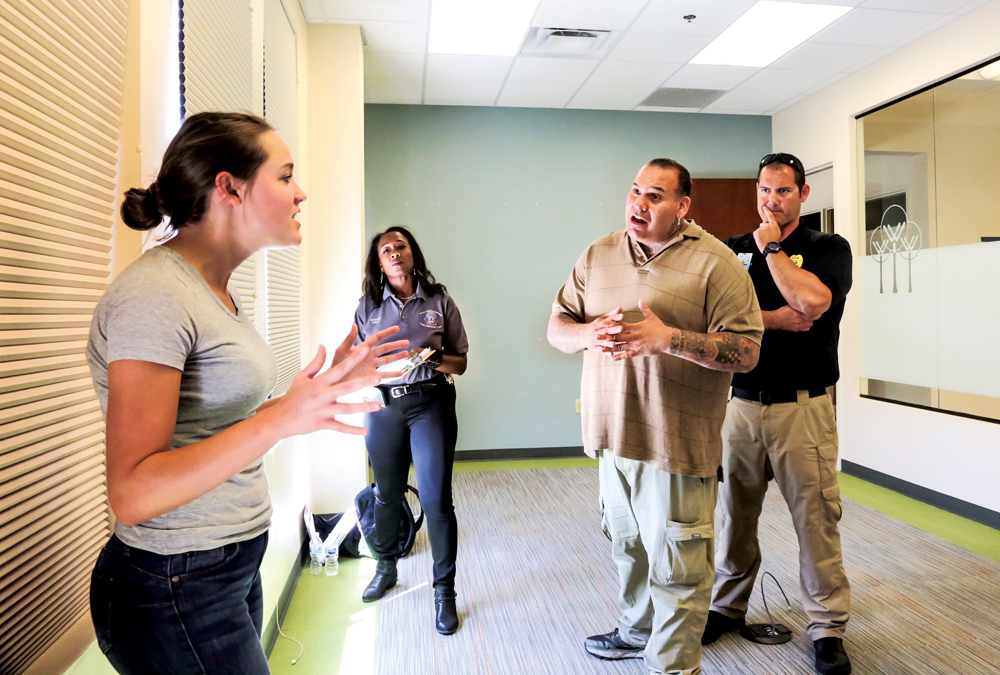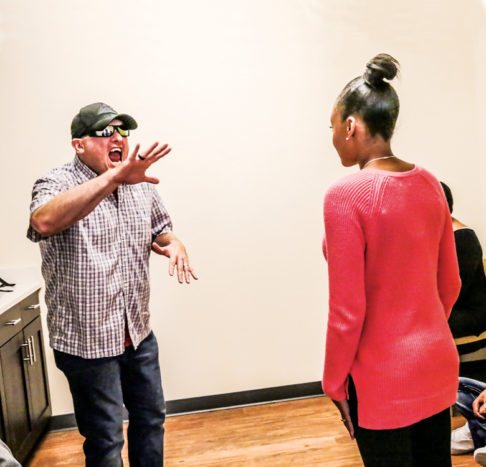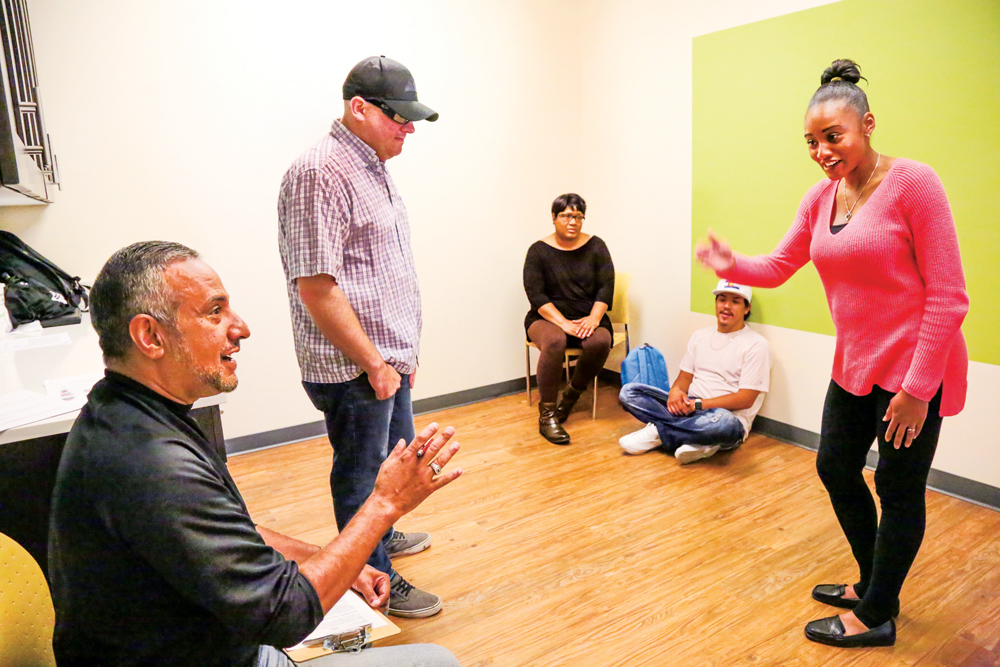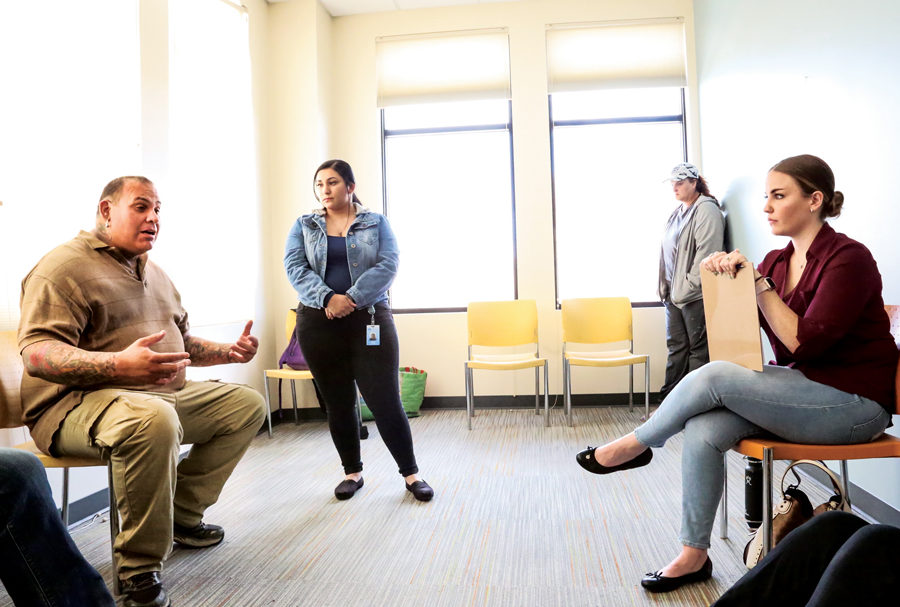
Sgt. Kip Sixbery (right) observes Campus Safety Officer Andrew Solano role-play de-escalation strategies learned during DPS Safety staff training.
“Oh my God. What was that? Are you kidding me? What the F+$@k is going on?” exclaims a livid young woman as she gesticulates wildly. Her expletive-laden speech escalates in tone and severity as her anger and frustration mount. A Denver Public Schools public safety staff member attempts to talk her down from the unreasonably aggressive language and body gestures. The irate woman is an actor playing out a scene that takes place at a DPS sporting event. The DPS staff member is employing newly acquired verbal and nonverbal techniques learned during de-escalation training.

DPS Campus Safety Officer (CSO) Marquaja Minor practices her CIT skills in a role-play with an actor portraying a volatile individual.
This past June, the DPS school board passed a resolution eliminating the use of handcuffs in elementary schools; the only exception is “if the student is openly displaying a deadly weapon,” according to the resolution. School board member Jennifer Bacon says the impetus for the decision came from several incidents involving handcuffs with young students, in particular one involving a 7-year old in Northeast Denver that received widespread media attention in the spring. “We have to move from being a reactive governing structure to a proactive one,” Bacon told the Front Porch in June.

CSO James Lopez observes while Coach Amir Stephen offers feedback on Minor’s work in the paused role-play.
As the media focused on the case of the 7-year old, DPS provided statistics showing 58 students had been handcuffed from 2017-2019. That number, however, almost tripled when DPS further reviewed its data and in August 2019 DPS said 155 students had been handcuffed from 2017-2019. Significantly, 45% of the 155 students handcuffed in this period were Black, though African American students make up only 13% of the DPS student population. DPS students of color are also disproportionately disciplined with suspensions and expulsions according to data on the Colorado Department of Education website.

CSO Esmeralda Galindo (standing) listens to an exchange between CSO Andrew Lozano and Coach Sarah Franz before engaging in a role-play exercise while others look on. The school board in June passed a resolution requiring five additional days of training for Safety staff across the district, part of a ban on handcuffs in elementary schools that received a lot of media attention.
The school board resolution on handcuffs instructs the superintendent to inform the board of each incident involving the use of handcuffs. “We can use that data to get down to zero…and ensure that we’re operating in a way that one demographic is not penalized more or more harshly,” says Bacon. A June email to the Front Porch from Will Jones, DPS Director of Media Relations, stated that DPS had not been aggregating its handcuff data in terms of race or ethnicity.
In cases where a student might be a danger to themselves or others but is not armed with a deadly weapon, NCI (Nonviolent Crisis Intervention) is the next step for staff, unarmed officers, and armed patrols. All schools have staff trained in NCI, which offers a variety of “soft restraints” trained staff can use if de-escalation proves unsuccessful, says Lt. Lisa Wehrli, who has been with DPS Department of Safety for over two decades. “This is not new to our department. It’s just one of the mandates we’re going to continually update.”
Department of Safety Staff also get 16 hours or more of training in implicit bias, trauma-informed care, and behavioral response, according to Jones, DPS.
The role-play with the irate woman at a DPS sporting event was just one of many roleplays DPS Safety staff engaged in as part of their mandatory 40-hour Crisis Intervention Training (CIT) certification.
The Department of Safety curriculum teaches a variety of de-escalation techniques. In the training session pictured here, Safety staff spent an entire afternoon getting feedback on their skills in a wide range of tense role-playing situations.
In one of the scenarios, a paranoid neighbor confronts a DPS representative, convinced that people are nightly unloading mysterious boxes to the nearby school cafeteria. The staffer works for several minutes to build rapport with the distressed and clearly irrational man. An instructor pauses the exercise to commend her and point out areas in which she excelled. He then reminds the DPS employee to use her voice and tone to further de-escalate the situation.
When the role-play resumes, she asks “Are you taking any medications by chance?” She verifies that the man has stopped taking his medication, and her follow-up questions cause him to pause briefly, successfully de-escalating the situation.
Though the Front Porch was unable to observe any role-plays centering on students, the goal is for officers and staff to be able to de-escalate troubling situations with students and avoid the use of handcuffs.
The June board resolution instructs DPS to significantly decrease handcuff use among middle and high school students, and requires the district to convene a Review Board each time handcuffs are used on a student. Beginning in August 2019, safety officers’ training increased by an additional five days. According to the resolution, “the District will utilize internal and external experts to ensure alignment with law, policy, and the District’s commitments to becoming a trauma-informed school district dedicated to the Whole Child and equity.”
Board member Dr. Carrie Olson says she recognizes that the resolution is just one step that’s needed to ensure the district is being pro-active. “The other big piece is to make sure the training is ongoing and to check in with students, schools, teachers, leaders, safety officers in the schools, and [Department of Safety Chief] Mike Eaton [and ask] how is it working? Are there tweaks we need to make? Is this what you need or is there something else?”




0 Comments